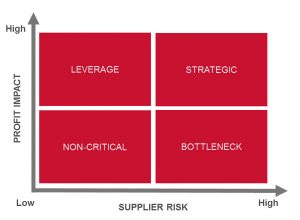Negotiating strategies for ProcurementPeter Kraljic’s Product Purchasing Classification Matrix has been used by procurement professionals for more than three decades. It enables buyers to classify goods and services that the company purchases and devise strategies according to the classifications.
However, a recent article, The Reinvention of Procurement by Jonathan Hughes and Danny Ertel, published by Vantage Partners, points out that Kraljic’s original Harvard Business Review article was published in 1983 and was very much focussed on the needs of manufacturing. Today procurement departments are dealing with ‘not only physical materials or equipment but also complex services and intangible assets like intellectual property, data and brand equity’.
Hughes and Ertel argue that procurement needs to adopt new strategies, more appropriate to the needs of our times. At Huthwaite, while we support their proposal, we would add that in order to support new strategies, procurement needs to adopt more appropriate behaviours for contemporary negotiation.

Supplier risk is about scarcity. How unique is the supplier’s solution? In other words, how many competitors does the supplier have? A supplier with few or no competitors will constitute high supplier risk.
The computer chip manufacturer that is making bespoke chips for a mobile phone company, jointly undertakes market research with the phone company and has some of its employees working on the phone company’s site would be very difficult to substitute and so constitutes a high supplier risk.
On the other hand, a supplier of office stationery to the mobile phone company will have many competitors and will be categorised by the phone company as low supplier risk.
Profit impact is about the financial impact of the good or service. How dependent is the company on the supplier for its financial success?
In the case of the computer chip manufacturer it is clear that its chips are at the heart of the mobile phone company’s product which means that it has high profit impact, whereas the supplier of office stationery has insignificant profit impact.
The Kraljic model enables buyers to categorise suppliers and devise strategies around these categories.
To return to the example of the mobile phone manufacturer, the computer chips clearly fall into the Strategic category and the strategy adopted by the phone manufacturer would probably include developing a long-term relationship with the supplier, closer cooperation, perhaps in the form of a joint venture or purchasing the supplier.
The office stationery falls into the Non-critical category so the phone company will try to optimise price, order volumes and inventory. It should be able to switch suppliers easily if a better deal were on offer. The phone company’s relationship with the stationery supplier will probably be transactional.
However the office stationery supplier may also supply paper to a printing company. In this case, the printer would probably regard the supplier as low risk but having high product impact and the stationery supplier’s paper would be categorised as a Leverage item. The printing company will try to leverage its purchasing power through high volume orders and by using substitute suppliers.
The computer chip manufacturer might also supply low tech chips to a company producing lighting systems. The profit impact is not high but the supplier risk is, so the lighting manufacturer would classify the chip supplier as Bottleneck. The problem for the lighting company is that, although the chips are of low profit impact it could be compromised by shortage of supply. Its strategy may then be to place large orders and stockpile chips to ensure consistent supply. In some cases buyers may encourage competition by assisting other companies to enter the market.
Quite clearly procurement has a role in enabling and supporting the strategic direction of any organisation. It’s critical that those suppliers deemed to be of strategic importance require a more strategic working relationship rather than just a series of ad hoc deals. But not all suppliers are equal or provide equal value and therefore don’t demand equal time. Kraljic’s model can help procurement to decide whether they need to treat suppliers collaboratively or competitively and where to focus their time.
A key difficulty for many procurement & supply chain professionals is different negotiating strategies need to be supported by different behaviours in negotiations.
For example, a steel manufacturer had a policy of promoting buyers from its steel mills to strategic procurement roles. Unfortunately these buyers had adopted the ‘take it or leave it’ approach that they used when negotiating with scrap metal dealers who were supplying scrap steel to the mills. Scrap metal was categorised as non-critical. Scrap dealers were faced with buyers using hard-ball tactics.
However, once promoted, the buyers continued to use this approach when dealing with strategic suppliers, with disastrous results.
This is where Huthwaite research can provide some critical insights for the procurement profession.
Huthwaite research into the behaviours of skilled negotiators revealed that the skilled negotiators spend more than three times as much of their time considering issues of common ground during the planning process, than average negotiators. Why is common ground so important?
The answer lies in how issues of common ground are used in the negotiation. Skilled negotiators will use the start of the negotiation to establish common ground in order to create a positive climate in which trust is highlighted. This provides a platform for positive bargaining as well as a useful reference point if the climate begins to deteriorate during the negotiation.
Trust is a key ingredient if negotiating a strategic deal. Failure to establish trust at the outset will mean that both sides will be reluctant to share information.
In referring to common ground, skilled negotiators use a behaviour termed Giving Feelings.
If you have always thought of skilled negotiators as having nerves of steel, never blinking and negotiating like poker players: dead pan, without a hint of what they are feeling, you would be wrong - Huthwaite research shows otherwise. Skilled negotiators do talk about their emotions: “I am happy with the current contract, “I’m worried that this won’t work out” or “I’m pleased we both view this as a long-term relationship”.
It should be noted that this behaviour is simply commentary on the negotiator’s internal thoughts and feelings meaning that the negotiator remains in control of her or his emotions. Giving Feelings does not mean throwing a temper tantrum or weeping.
Huthwaite research found that skilled negotiators use Giving Feelings almost twice as much as average negotiators. This, in conjunction with reference to common ground, helps to establish and maintain trust.
Failure to develop common ground and establish trust at the outset of each negotiation will mean that both sides will be reluctant to share critical information about business goals, strategy, the importance of issues, sensitive information, concerns and fears. This failure to collaborate and share information ultimately results in poor bargaining/trading. An overwhelming lack of trust can ensue, resulting in little or no movement from either party and positions becoming entrenched.. Ultimately, a sub-optimal deal is likely and any attempt at creativity or generating additional value is doomed. At its worst this will damage relationships and risk continuity of supply.
Remember those steel mill negotiators?
What we learn from this is that the different strategies that are used to negotiate with strategic suppliers require different behavioural strategies. In other words, to negotiate effectively with strategic suppliers requires that procurement professionals have sufficient self-insight and behavioural flexibility to negotiate in a way that circumstances demand.
In my next blog I will look at other behaviours and the impact that they have on procurement negotiations.








